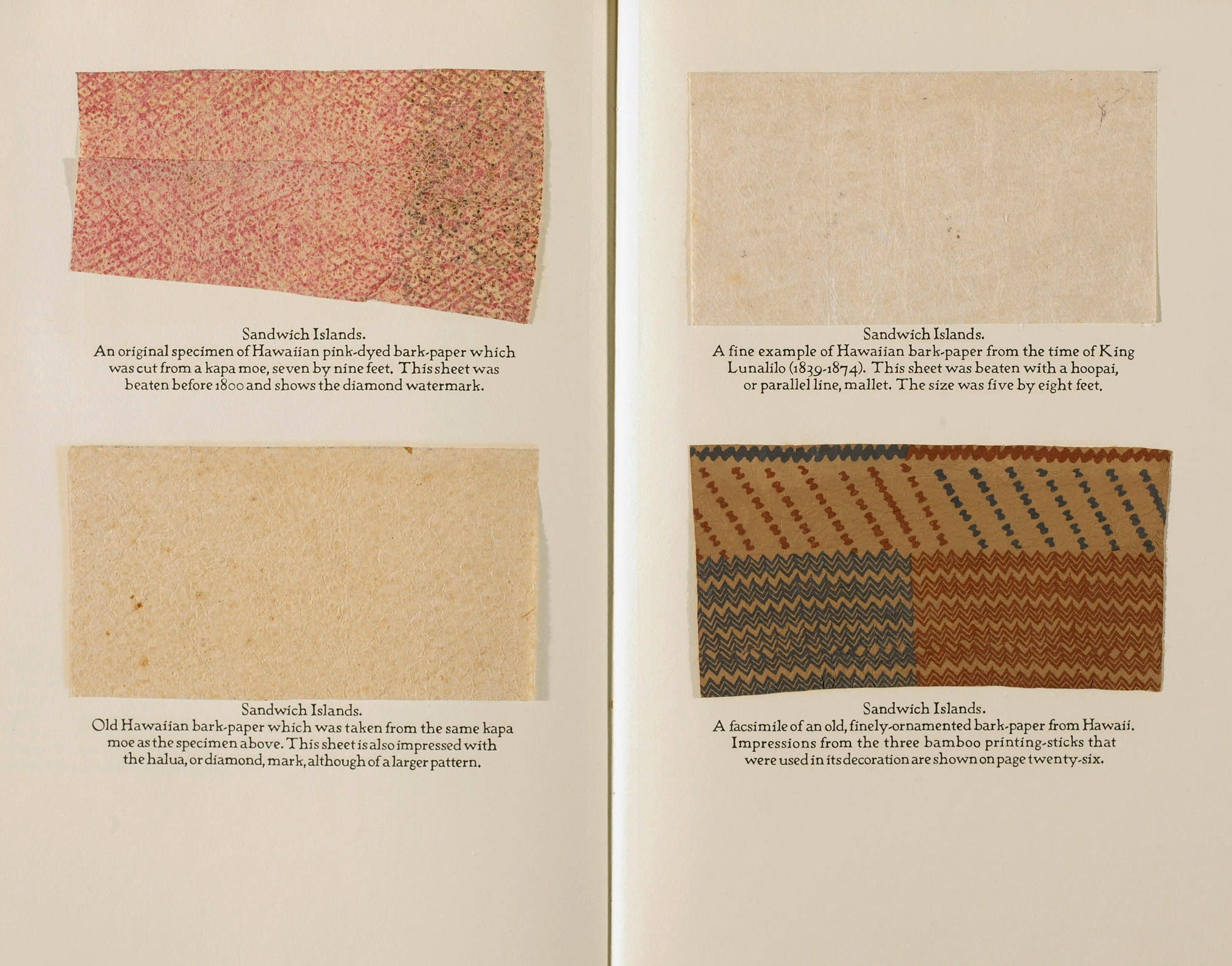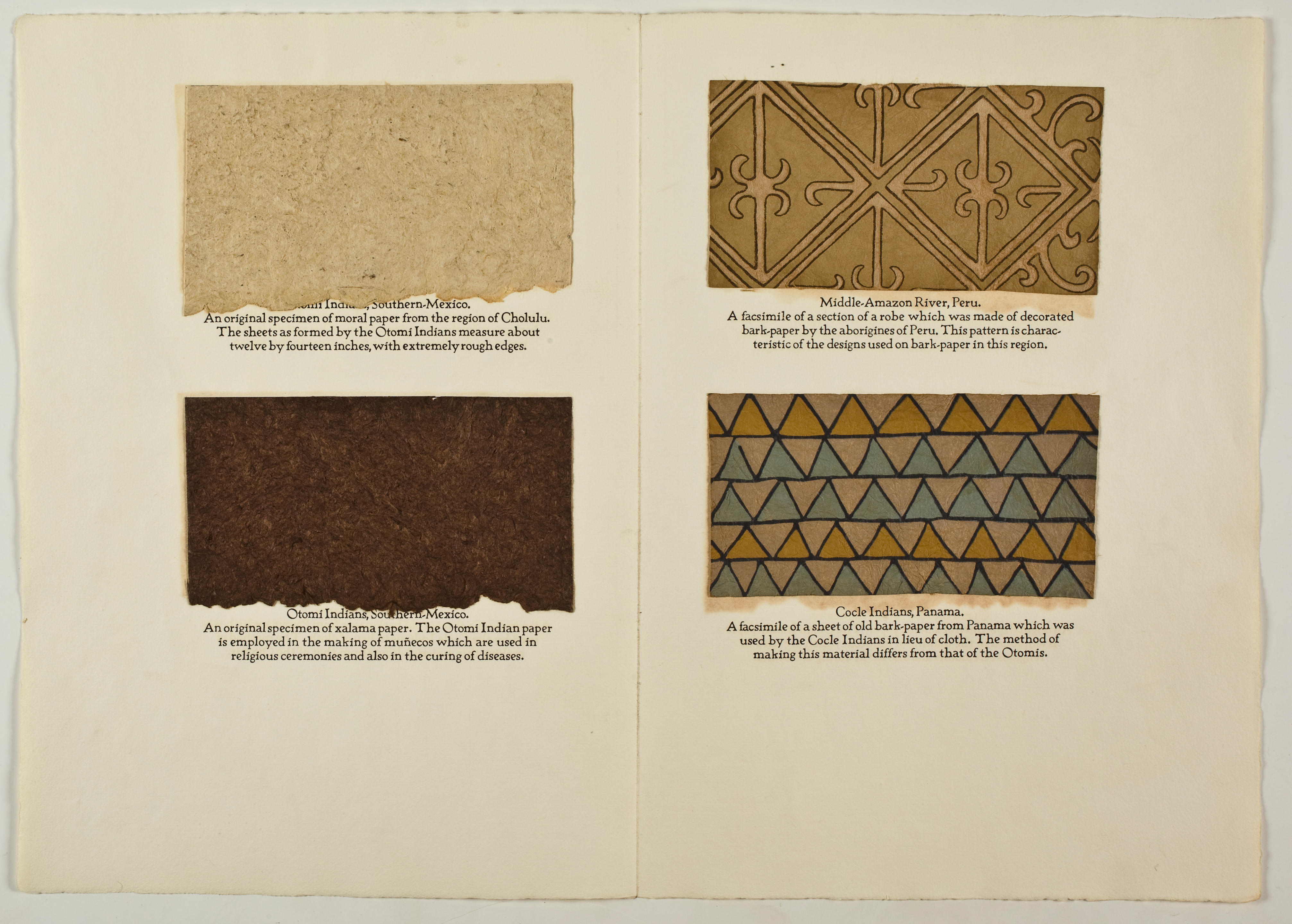Hunter, William Joseph "Dard." Primitive Papermaking. Chillicothe (OH): Mountain House Press, 1927. Folio, loose signatures in hardcover portfolio, three-quarter cloth over paper boards, cloth ties on 3 sides, 48 numbered pages, with 32 tipped in samples of paper and bark, one two-page plate, 10 other plates. Limitation page indicates that this is number 6 of 200; signed by Hunter. Plus prospectus for this volume (4-pages) and a small pamphlet for the Dard Hunter Paper Museum at the Institute of Paper Chemistry (small 8vo, 24pp in printed wraps). The museum was originally housed at MIT (Massachusetts Institute of Technology) from 1939 to late 1954 when it was moved to the Institute of Paper Chemistry in Appleton, Wisconsin. Born William Joseph Hunter in Steubenville, Ohio to a newspaper owner/publisher, Dard grew up with an appreciation of printing and the value of hand crafts. His father embraced progress, but did not think that hand crafting should be sacrificed in the name of that progress. Dard was surrounded by the printing business at a young age. His father hired him as an artist when he moved to Chillicothe to operate another paper, but Dard became restless. He joined his brother, Philip, an accomplished magician as a "chalk-talker," entertaining audiences between acts. In his travels, he encountered the Arts & Crafts style and was hooked. In 1904 he applied for a summer position with Elbert Hubbard and the Roycrofters. Even though he had been turned down for the position, he showed up anyway, and was hired. Here he learned stain glass, and other crafts in metal, leather, and paper, and helped to establish the Roycroft line as a distinctive product (today, "branding"). He also experimented with jewelry, pottery and furniture. After several years, he became disillusioned with the commercialism of Roycrofters. He married Roycroft pianist Edith Cornell in 1908 and the couple spent their honeymoon in Vienna. He studied design with European artists. He later studied lithography, book decoration and letter design in Vienna. He then moved to London, where he encountered papermaking tools at the London Science Museum, and decided to learn more about this ancient craft. When Dard and Edith returned to America, they settled in Marlborough, NY. He found that no one was making handmade paper in the US at that time, and decided to fill the void. Wanting to be "true" to the 17th century craft, he built a mill along Jew's Creek and used only water to power his operation. It was here that he planned and executed the first book to be written and constructed by one man. He cut his own typeface, made his own paper, bound his own book. In 1919 the family moved back to Chillicothe, and purchased the Mountain House. He started Mountain House Press in one wing of the house. He would go on to author 20 books on papermaking, eight of which he printed by hand. The present volume is one of those, printed by hand in limited numbers. This volume is the one Hunter considered his finest. It was his first on international, non-Western papermaking. Most of this volume concerns the production of tapa in the Pacific and in Southeast Asia. The introduction makes the case that although usually termed "bark-cloth" by westerners, this material made by beating the fibers of the inner barks of trees into sheets is actually paper. The first explorers to encounter this material termed it "cloth" primarily because of its uses - it was used for clothing in most places it was made - not because of its construction. Hunter argues that it is truly paper, not cloth as it has more characteristics in common with the latter material. Hunter spent many years trying to acquire samples of tapa from different areas for inclusion in the volume, many of which are over a century old. In addition to being produced in limited quantities, the scarcity of this book is also affected by lack of available samples. Hunter noted the affinity of "silverfish" to this material, and the cr
Hunter, William Joseph "Dard." Primitive Papermaking. Chillicothe (OH): Mountain House Press, 1927. Folio, loose signatures in hardcover portfolio, three-quarter cloth over paper boards, cloth ties on 3 sides, 48 numbered pages, with 32 tipped in samples of paper and bark, one two-page plate, 10 other plates. Limitation page indicates that this is number 6 of 200; signed by Hunter. Plus prospectus for this volume (4-pages) and a small pamphlet for the Dard Hunter Paper Museum at the Institute of Paper Chemistry (small 8vo, 24pp in printed wraps). The museum was originally housed at MIT (Massachusetts Institute of Technology) from 1939 to late 1954 when it was moved to the Institute of Paper Chemistry in Appleton, Wisconsin. Born William Joseph Hunter in Steubenville, Ohio to a newspaper owner/publisher, Dard grew up with an appreciation of printing and the value of hand crafts. His father embraced progress, but did not think that hand crafting should be sacrificed in the name of that progress. Dard was surrounded by the printing business at a young age. His father hired him as an artist when he moved to Chillicothe to operate another paper, but Dard became restless. He joined his brother, Philip, an accomplished magician as a "chalk-talker," entertaining audiences between acts. In his travels, he encountered the Arts & Crafts style and was hooked. In 1904 he applied for a summer position with Elbert Hubbard and the Roycrofters. Even though he had been turned down for the position, he showed up anyway, and was hired. Here he learned stain glass, and other crafts in metal, leather, and paper, and helped to establish the Roycroft line as a distinctive product (today, "branding"). He also experimented with jewelry, pottery and furniture. After several years, he became disillusioned with the commercialism of Roycrofters. He married Roycroft pianist Edith Cornell in 1908 and the couple spent their honeymoon in Vienna. He studied design with European artists. He later studied lithography, book decoration and letter design in Vienna. He then moved to London, where he encountered papermaking tools at the London Science Museum, and decided to learn more about this ancient craft. When Dard and Edith returned to America, they settled in Marlborough, NY. He found that no one was making handmade paper in the US at that time, and decided to fill the void. Wanting to be "true" to the 17th century craft, he built a mill along Jew's Creek and used only water to power his operation. It was here that he planned and executed the first book to be written and constructed by one man. He cut his own typeface, made his own paper, bound his own book. In 1919 the family moved back to Chillicothe, and purchased the Mountain House. He started Mountain House Press in one wing of the house. He would go on to author 20 books on papermaking, eight of which he printed by hand. The present volume is one of those, printed by hand in limited numbers. This volume is the one Hunter considered his finest. It was his first on international, non-Western papermaking. Most of this volume concerns the production of tapa in the Pacific and in Southeast Asia. The introduction makes the case that although usually termed "bark-cloth" by westerners, this material made by beating the fibers of the inner barks of trees into sheets is actually paper. The first explorers to encounter this material termed it "cloth" primarily because of its uses - it was used for clothing in most places it was made - not because of its construction. Hunter argues that it is truly paper, not cloth as it has more characteristics in common with the latter material. Hunter spent many years trying to acquire samples of tapa from different areas for inclusion in the volume, many of which are over a century old. In addition to being produced in limited quantities, the scarcity of this book is also affected by lack of available samples. Hunter noted the affinity of "silverfish" to this material, and the cr















Try LotSearch and its premium features for 7 days - without any costs!
Be notified automatically about new items in upcoming auctions.
Create an alert